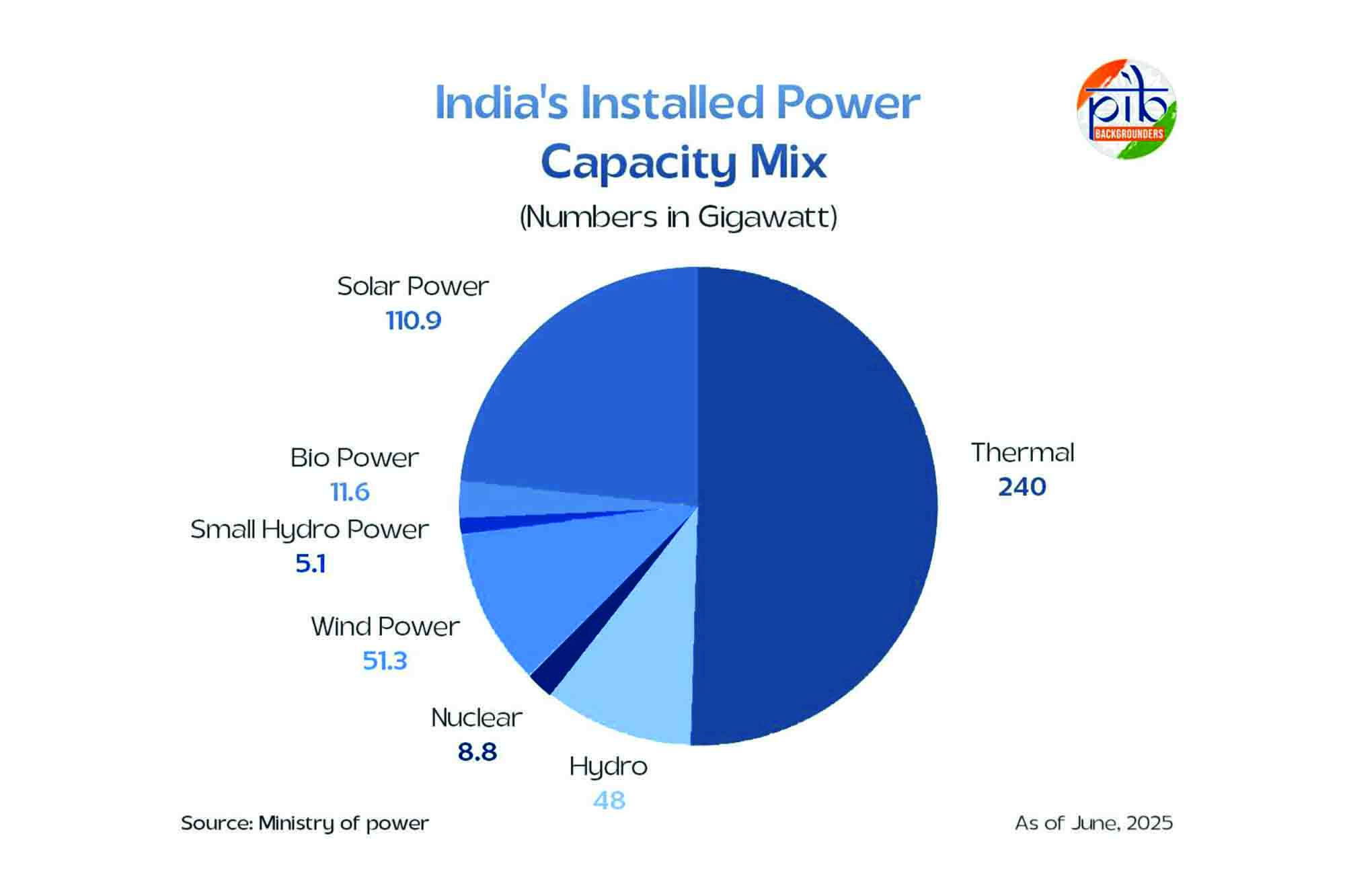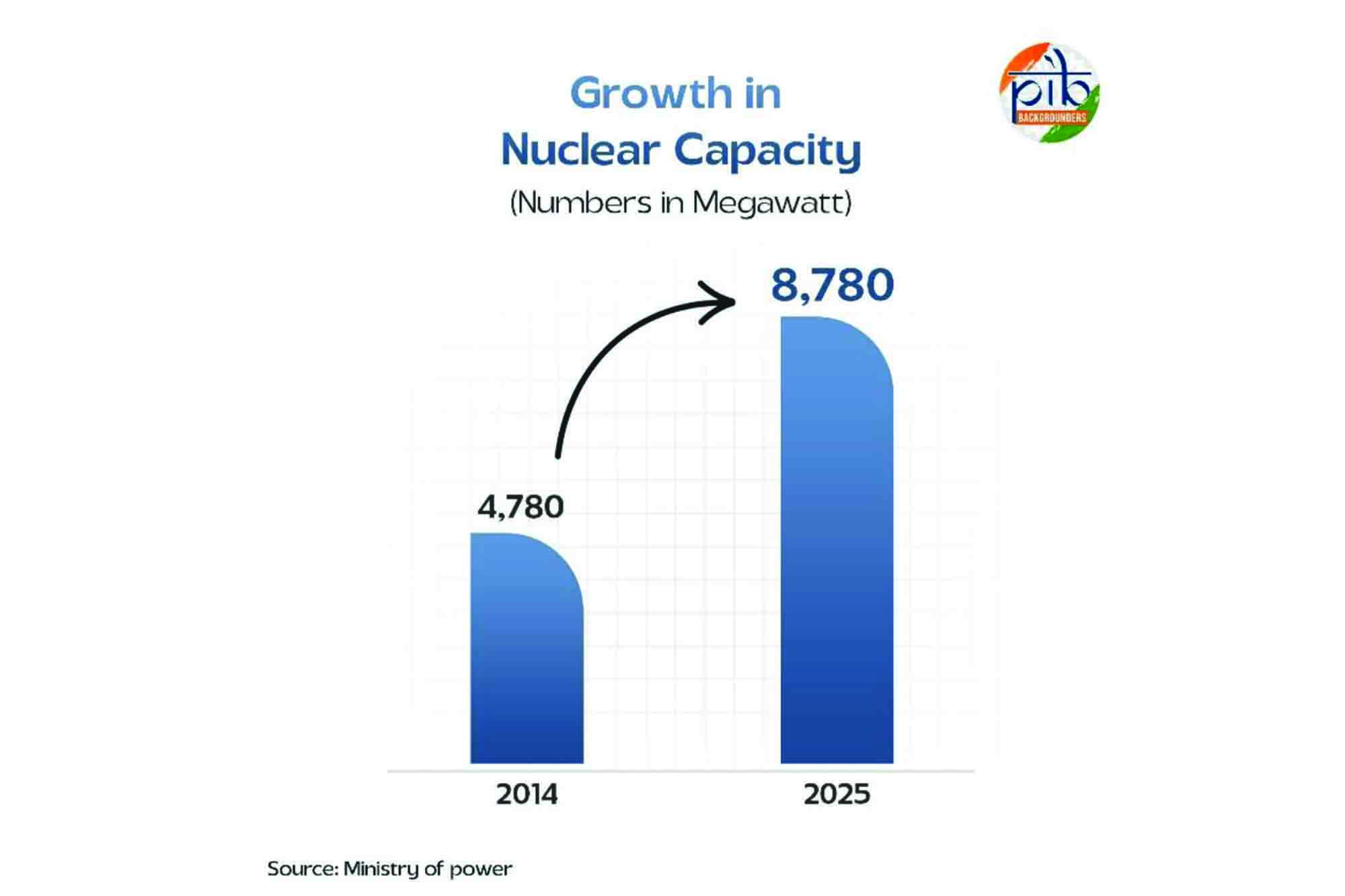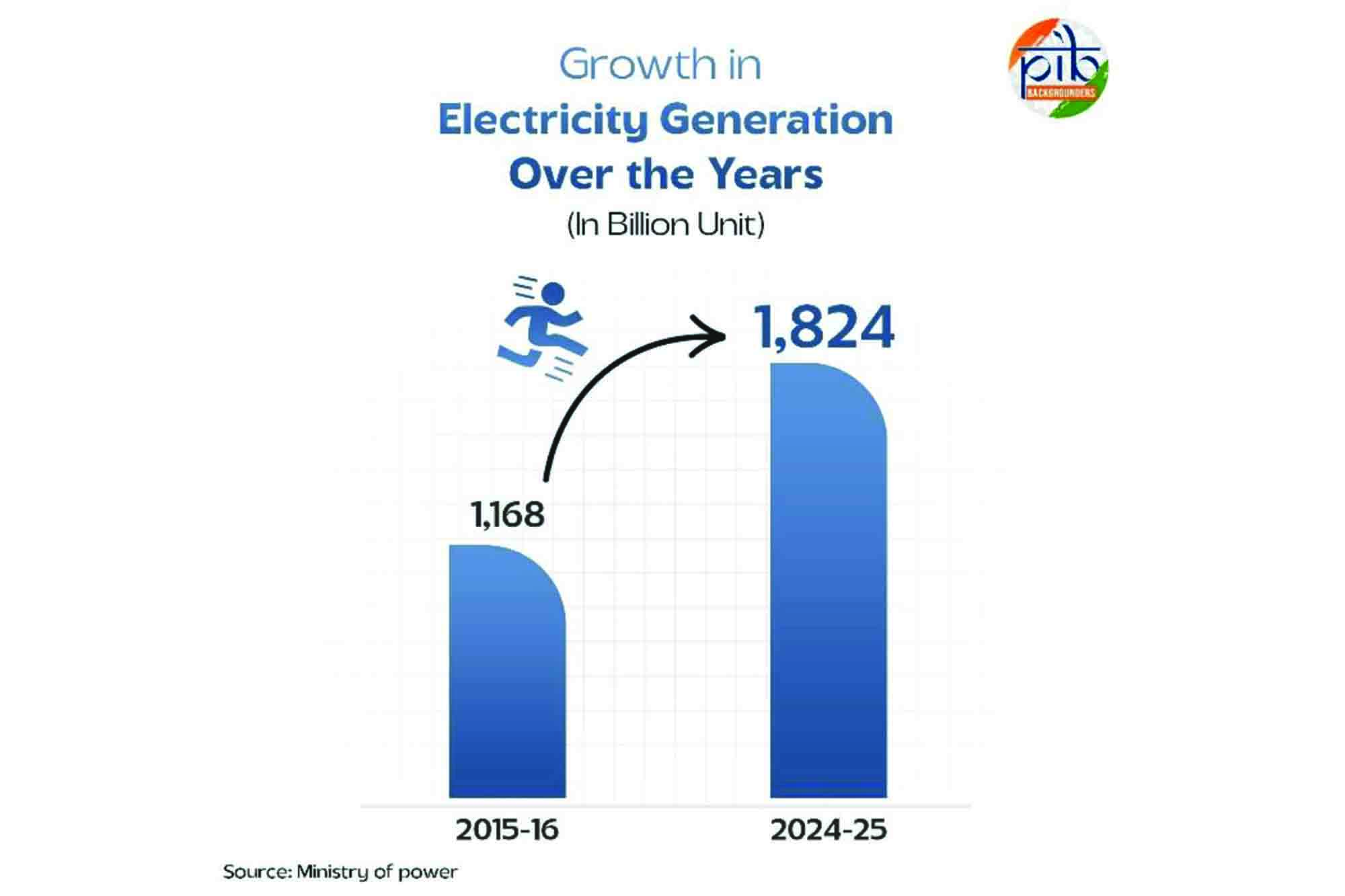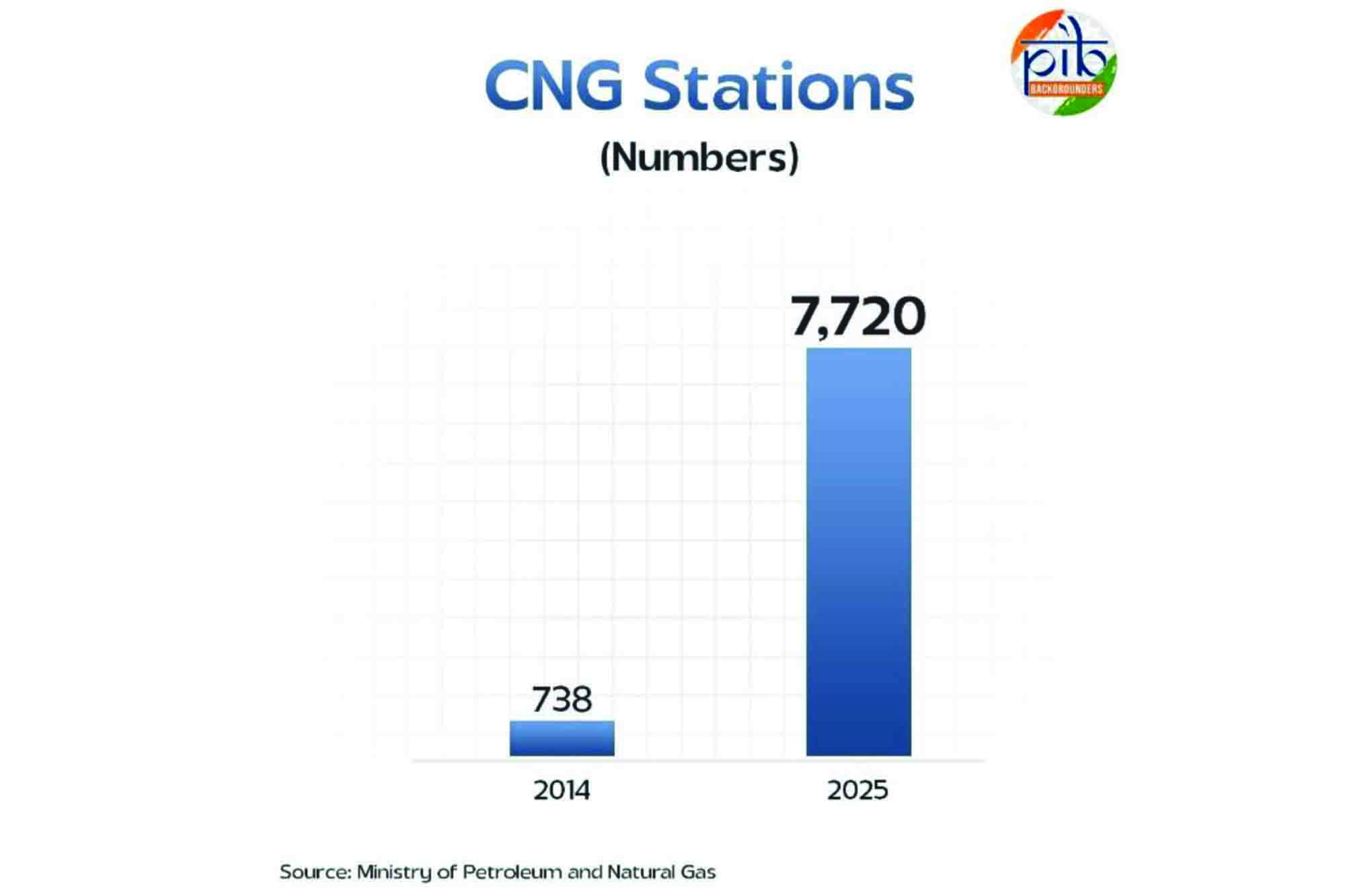India delivers, energy sector hits new heights
By Staff Report September 3, 2025 12:26 pm IST
By Staff Report September 3, 2025 12:26 pm IST

According to government data, the total installed power capacity reached 476 GW as of June 2025, and per capita electricity consumption increased by 45.8 per cent.
India has made significant progress in strengthening its energy sector in recent years. The country is successfully balancing the twin goals of meeting rising electricity demand and promoting sustainability. As per government figures, electricity generation has increased from 1,168 billion units (BU) in 2015–16 to an estimated 1,824 BU in 2024–25. India achieved 100 percent village electrification by April 2018 and has since connected more than 2.8 crore households to the grid. Counting on the reduction in power shortages, it reduced from 4.2 percent (2013-14) to 0.1 percent (2024-25). Also, the per capita electricity consumption rose by 45.8 percent to 1,395 kWh in 2023-24 from 957 kWh in 2013-14.
Renewable power generation

Much has been said about solar and wind. Let us know about the other sectors like hydropower, bio energy and nuclear energy.
As of June 2025, India’s total installed power capacity has reached a significant milestone with 476 GW, led by 240 GW of thermal, 110.9 GW of solar and 51.3 GW of wind power, marking a strong shift towards renewable energy and energy security.
Hydro power: Hydro capacity increased from 35.8 GW to 48 GW from FY 2014 to FY 2025. Targeting 55 GW by FY 2030, supported by Inter-State Transmission System (ISTS) charges waivers and equity assistance for North East projects.

Biopower: Biopower generation capacity has increased from 8.1 GW to 11.6 GW over the last 11 years. Compressed Biogas (CBG) generation capacity expanded from a single project with 8 Tonnes per Day (TPD) in 2014 to 150 projects with a cumulative capacity of 1,211 TPD as of March 2025.
National bioenergy programme
The Ministry of New and Renewable Energy launched the National Bioenergy Programme on 2 November 2022. It covers the period from 1 April 2021 to 31 March 2026. The total budget outlay is ₹1715 crore. Phase-1 has been approved with ₹858 crore, including committed liabilities.
The programme includes three key components. The ‘Waste to Energy Programme’ focuses on harnessing urban, industrial and agricultural waste for energy generation. The ‘Biomass Programme’ promotes the development of briquette and pellet plants as well as biomass-based cogeneration projects. Meanwhile, the ‘Biogas Programme’ supports the establishment of small-scale (1–25 m³/day) and medium-scale (25–2500 m³/day) biogas plants, facilitating cleaner energy production from organic waste.
As of 31 March 2025, the biomass and waste-to-energy sector has made notable strides. The cumulative installed capacity of biomass power and cogeneration stands at 9.82 GW for bagasse and independent power producers (IPPs), and 0.92 GW for non-bagasse sources. Waste-to-energy capacity totals 840.21 MWeq, comprising 309.34 MW of grid-connected and 530.87 MWeq of off-grid installations. Under the broader Biomass Programme, the cumulative installed capacity reaches 11.583 GW. In the biogas segment, 51.04 lakh small plants and 361 medium plants have been installed, contributing a cumulative off-grid power generation capacity of 11.5 MW.

The nuclear energy sector has witnessed significant expansion and modernisation over the past decade. With a focus on clean energy, indigenous technology and performance excellence, the country has scaled up both its operational capacity and future potential.
Between 2014 and 2025, India achieved milestones in nuclear energy. Annual nuclear electricity generation increased by 60 percent rising from 35,592 MUs in 2014–15 to 56,681 MUs in 2024–25. Installed nuclear capacity grew by 71 percent expanding from approximately 4,780 MW in 2014 to 8,780 MW in 2025, distributed across 25 reactors operated by the Nuclear Power Corporation of India Limited (NPCIL). The sector also achieved a Plant Load Factor of 87 percent in the financial year 2024–25, with capacity and availability factors exceeding 80 percent for all operating reactors over the past five years.Conventional power generation
As of June 2025, coal remains the dominant contributor with a capacity of 219 GW. Gas-based power contributes 20 GW, and diesel-based power adds another 589 MW. Thermal power alone accounts for 50.52 percent of India’s total installed energy capacity, underscoring its central role in meeting the nation’s electricity demands. These sources collectively make up a total thermal capacity of 240 GW. Among this, coal alone contributes over 91 percent of the total thermal energy, highlighting its critical role in powering the nation.

Coal sector: Over the past eleven years, India’s coal sector has witnessed a remarkable transformation under the Ministry of Coal. With a focus on self-reliance, sustainability and efficiency, major reforms and infrastructure development have enabled record production, significant import reduction and cleaner, more transparent operations.
Revenue paid to the coal-bearing states led to improvements in infrastructure, healthcare, education, socio-economic growth and ‘ease of living’ for citizens. Coal PSUs distributed a total revenue of ₹1.8 lakh crores to coal-bearing states since 2014-15. Coal production increased from 609.18 million tonnes (MT) in 2014–15 to 1,047.68 MT in 2024–25, a rise of 72 percent. The supply grew from 603.77 MT to 1,025.25 MT, meeting rising domestic demand, especially in power generation.
Out of the total 124 coal blocks allocated under the Commercial Mining Policy (launched June 2020), 17 are already operational. Production from captive/commercial mines jumped from 52.7 MT (2014–15) to 190.95 MT (2024–25), a rise of 262 percent. To ensure a sustainable future, the coal sector is shifting towards a balanced energy mix by adopting renewables like solar and wind, while offsetting past environmental impacts through carbon capture, reforestation and clean energy initiatives.
Oil and gas sector: The oil and gas sector is one of the nation’s eight core industries and plays a pivotal role in driving the country’s economic engine. India is the third-largest consumer of oil in the world (as of 2023), making this sector crucial for energy security and future growth, as our GDP is expected to grow to US$8.6 trillion by 2040. The energy demand, especially oil and natural gas, is set to nearly double to 1,123 million tonnes of oil equivalent. This makes the sector increasingly attractive for both domestic and international investments.
Between 2014 and 2025, India witnessed a remarkable expansion in its natural gas and biofuel infrastructure. Piped Natural Gas (PNG) connections grew nearly sixfold, from 0.254 crore in 2014 to 1.47 crore in 2025, while Compressed Natural Gas (CNG) stations saw a more than tenfold increase, from 738 to 7,720. The City Gas Distribution (CGD) network expanded from 53 to 307 geographical areas, resulting in a population coverage rise from 13.27 percent to nearly 100 percent and an area coverage jump from 5.58 percent to approximately 100 percent by 2025.

Operational natural gas pipelines increased from 15,340 km to 25,124 km, and the number of LNG terminals doubled from four to eight, with their capacity growing from 22 MMTPA to 52.7 MMTPA. Under the National Policy on Biofuels (2018, amended in 2022), India targeted 20 percent ethanol blending by 2025–26, achieving an increase from 1.53 percent in 2014 to 18.5 percent in 2025. Correspondingly, ethanol procurement surged from 38 crore litres in 2014 to 440.74 crore litres in 2025, while biodiesel procurement rose sharply from 1.19 crore litres in 2015–16 to 43.99 crore litres in 2024.
Conclusion
The energy capacity is not only being increased, but there are ongoing initiatives to redefine the way India consumes and generates power. The energy journey over the past decade has witnessed a shift to self-reliance, sustainability and innovation. From rural electrification to digital procurement, every initiative underscores the nation’s vision of inclusive, secure and clean energy for all. As India moves forward, its balanced and forward-looking energy strategy continues to power economic growth and a sustainable future.
***************************
We use cookies to personalize your experience. By continuing to visit this website you agree to our Terms & Conditions, Privacy Policy and Cookie Policy.